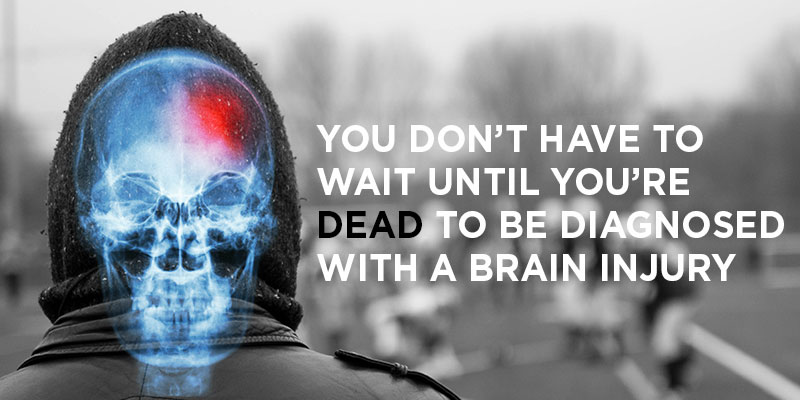
Ask yourself if you have ever:
• Blacked out for a few seconds?
• Seen stars?
or
Have you ever:
• Played football, baseball, basketball, lacrosse, soccer, rugby or hockey?
• Fallen out of a tree, down the stairs, off a horse, a bike or a skateboard, or crashed while skiing or snowboarding?
• Been in a motor vehicle accident (even a simple “fender-bender”) or physically assaulted?
If you answered “yes” to any of these, you may actually have injured your brain—even if you didn’t get diagnosed with a concussion.
So how can you find out?
In a helpful demonstration of the usefulness of SPECT imaging for identifying brain-based disorders, a new study shows that current and former NFL players experience low blood flow to the brain, compared to a healthy group. The researchers examined the brains of the largest group of retired and current NFL players investigated to date; a total of 161 individuals with an average age of 52. The results of the study, recently published in the Journal of Alzheimer’s Disease, may help physicians to provide better treatment to people with head injury.
“Without functional imaging studies like SPECT, it is very difficult to know if brain trauma is present and which areas are affected,” points out lead author Daniel G. Amen, MD. “Structural studies often appear normal but what we can do better with functional neuroimaging with SPECT is not only pinpoint specific areas of the brain that are unhealthy with low blood flow, but also demonstrate their improvement with successful brain rehabilitation treatments in persons like football players.”
This study further supports that fact that brain SPECT imaging is one of the best tools available to identify areas of the brain hurt by an injury. A CT (“CAT”) scan or MRI will tell you if there is any damage to the anatomy or structure of your brain, but these scans cannot tell how your brain is functioning. In fact, many times a CT or MRI will be normal after a head injury, when there is actually functional damage to the brain that can be detected with SPECT.
Co-author Dr. Bennet Omalu, who discovered Chronic Traumatic Encephalopathy (CTE) in former football players as portrayed in the movie Concussion, added, “What our current work is doing, in addition to other imaging modalities, builds the foundation for identifying the negative effects of head trauma on the brain while the patient is still alive so that we can intervene with better treatments.”
CTE is a progressive degenerative disease of the brain found in athletes (and others) thought to result from repeated hits to the head. It is important to note that undiagnosed sub-concussive blows may also contribute to CTE. However, the actual diagnosis of CTE can be confirmed only with an autopsy.
According to Dr. Amen, The two big takeaways from the study are:
1) You don’t have to wait until you’re dead to be diagnosed with a brain injury. With SPECT, we were able to see traumatic brain injuries in virtually all of the football players we studied, and some are recently retired.
2) We determined that you’re not stuck with the damage you have, you can get treated.
Dr. Amen and the physicians at Amen Clinics are very knowledgeable about the consequences of repetitive blows to the head, including how to identify them and heal the brain. If you are concerned that you or a loved may have a head injury, a call to our Care Center can answer your questions and provide you with valuable information that can lead you to a better brain and a better life. Find out how. Call 888-288-9834 or schedule a visit today.





My husband and I were hit head on by a bus. I had a SPECHT scan that showed damage. I also had a MEG test that showed even a better picture of where the damage was. UC San Diego Neurology is using this on soldiers before active duty and after they return. We had to go to trial and we lost because of pictures showing me pushing a grocery cart and taking my granddaughter to the beach. My quest is to help people know that just because we look normal, brain trauma is real and the word needs to get out. I would love to have more help. Thank you for sharing your information.
Comment by Jackie Peebles — May 5, 2016 @ 5:11 AM
What treatments do you offer? I was diagnosed with a concussion and subsequently post-concussive syndrome. Rest is all I was told to do and was restricted from driving for a few weeks. I’m an M.D./Ph.D. so I wasn’t exactly satisfied with that approach. Standard doctors aren’t much help. I’ve been taking tons of supplements, especially Omega-3 and curcumin, among others (whose purity I’m always concerned about). I did one session of TMS, which I’m not sure is a good idea or not. I’m considering hyperbarics and neurofeedback techniques, all expensive and not covered by insurance. What is your approach?
Comment by Jennifer Green Greenhall — May 5, 2016 @ 11:26 AM
Wow, to be a patient as a healthcare provider is hard. I’m a MSN, RN and I am taking a supplement, EHT, by Nerium that was developed by Princeton University labs and Signum Bioscience which helps reduce tau and alpha-synuclein hyperphosphorylation. I am sure you know way more about this process than I, but as an aortic arch repair survivor with controlled brain injury via DHCA, 23 minutes, I lived with brain damage for years. After taking this supplement for 11 months I am getting my memory back and so much more. Good luck, I do hope you find some help.
Comment by Mary Harris — May 5, 2016 @ 12:50 PM
Wow, sounds like you all are lucky to be alive. I am not sure this will help, but I am taking a supplement, EHT, by Nerium that was developed by Princeton University labs and Signum Bioscience which helps reduce tau and alpha-synuclein hyperphosphorylation. I am an aortic arch repair survivor with controlled brain injury (via deep hypothermic circulatory arrest -DHCA), 23 minutes, I lived with brain damage for years. After taking this supplement for 11 months I am getting my memory back and so much more. Good luck, I do hope you find some help.
Comment by Mary Harris — May 5, 2016 @ 12:56 PM
I have had several TIAs. With the worst one, I blacked out. I’ve also had multiple blunt force hits to the head throughout my life, one at the back of my head and others in the front of my head above the hairline. I will start the classes Dr. Amen’s started last Wednesday, May 4th, 2016 online.
Comment by Jeanie — May 5, 2016 @ 12:58 PM
Thanks for the advice. I’ll look it up. I wish there were better “official” therapies out there!
Comment by Jennifer Green Greenhall — May 5, 2016 @ 1:10 PM
Thank you, I will look in to EHT
Comment by Jackie Peebles — May 5, 2016 @ 2:27 PM
You’re welcome.
Comment by Mary Harris — May 5, 2016 @ 2:37 PM
I hear you, I didn’t have anything until this supplement and I have to say I am surprised it helped. Take good care.
Comment by Mary Harris — May 5, 2016 @ 2:38 PM
I hope you don’t mind me responding to this post but I do read anything dr.amen puts up on this site. I also take EHT and although I don’t have a head injury have found that I sleep much deeper and dream again…one of the changes I had with aging.
EHT can only be purchased through a Nerium Brand Partner which I happen to be one of. If you’re interested please check out my web site…lots a great information there. Hope this is helpful.
Comment by Kathryn — May 5, 2016 @ 4:12 PM
I hope you don’t mind me responding to this post as well as the previous one but I do read anything dr.amen puts up on this site. I also take EHT and although I don’t have a head injury have found that I sleep much deeper and dream again…one of the changes I had with aging.
EHT can only be purchased through a Nerium Brand Partner which I happen to be one of. If you’re interested please check out my web site…lots a great information there. Hope this is helpful.
Comment by Kathryn — May 5, 2016 @ 4:14 PM
Kathryn, we appreciate your support of Dr. Amen’s work, and at the same time would appreciate it if you would not solicit clients for Nerium on our blogs. Thank you.
Comment by Amen Clinics — May 6, 2016 @ 10:17 AM
Hi Jackie,
Dr. Amen and Tana Amen are hosting a free live class every Wednesday at 5:30 pm PST which you can attend in person or view online. The class goes until October. We think you might find it very helpful in recovering from brain trauma. Here is the link for signing up: www.brainwarriorswaylive.com
Comment by Amen Clinics — May 6, 2016 @ 10:23 AM
If you are concerned about TMS which pulses energy into your brain, you might want to try EEG Neurofeedback. It is non-invasive and non-pharmacological. I am currently using it as a provider with veteran with TBIs and also with some young men who repeatedly had the bells rung while playing football. It can be very effective in a short period of time. The brain has a lot of plasticity, meaning it can repair itself. Neurofeedback leads to better self regulation, which also means increasing blood flow to areas where neurotransmission was disrupted by the injury.
Comment by Hanno Kirk — May 30, 2016 @ 1:19 PM
Thank you. It’s on my radar for next thing to try. Right now I’m trying hyperbaric oxygen therapy. I’m told I’ll need between 20-40 1 hr treatments (meaning, I shouldn’t see an improvement until 20 but if I don’t see any by 40, I won’t).
Comment by Jennifer Green Greenhall — May 30, 2016 @ 2:19 PM